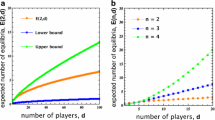Abstract
In evolutionary game theory, the central solution concept is the evolutionarily stable state, which also can be interpreted as an evolutionarily stable population strategy (ESS). As such, this notion is a refinement of the Nash equilibrium concept in that it requires an additional stability property. In the present paper, an algorithm for detectingall ESSs of a given evolutionary game consisting of pairwise conflicts is presented which both is efficient and complete, since it involves a procedure avoiding the search for unstable equilibria to a considerable extent, and also has a finite, exact routine to check evolutionary stability of a given equilibrium. The article also contains the generalization of these results to the playing-the-field setting, where the payoff is nonlinear.
Similar content being viewed by others
References
Maynard Smith, J., andPrice, G.,The Logic of Animal Conflict, Nature, Vol. 246, pp. 15–18, 1973.
Maynard Smith, J.,The Theory of Games and the Evolution of Animal Conflict, Journal of Theoretical Biology, Vol. 47, pp. 209–221, 1974.
Stewart, F. M.,Evolution of Dimorphism in a Predator-Prey Model, Theoretical Population Biology, Vol. 2, pp. 493–506, 1971.
Bomze, I. M., andvan Damme, E. E. C.,A Dynamical Characterization of Evolutionary Stability, Annals of Operations Research, Vol. 37, pp. 229–244, 1992.
Bomze, I. M.,Dynamical Aspects of Evolutionary Stability, Monatshefte für Mathematik, Vol. 110, pp. 189–206, 1990.
Bomze, I. M.,Noncooperative Two-Person Games in Biology: A Classification, International Journal of Game Theory, Vol. 15, pp. 31–57, 1986.
Van Damme, E. E. C.,Stability and Perfection of Nash Equilibria, Springer, Berlin, Germany, 1987.
Haigh, J.,Game Theory and Evolution, Advances of Applied Probability, Vol. 7, pp. 8–11, 1975.
Bishop, D. T., andCannings, C.,Models of Animal Conflict, Advances of Applied Probability, Vol. 8, pp. 616–621, 1976.
Williams, H. P.,Evolution, Game Theory, and Polyhedra, Journal of Mathematical Biology, Vol. 25, pp. 393–409, 1987.
Abakuks, A.,Conditions for Evolutionarily Stable Strategies, Journal of Applied Probability, Vol. 17, pp. 559–562, 1980.
Bomze, I. M. andPötscher, B. M.,Game Theoretic Foundations of Evolutionary Stability, Springer, Berlin, Germany, 1989.
Parthasarathy, T., andRaghavan, T. E. S.,Some Topics in Two-Person Games, Elsevier, New York, New York, 1971.
Bomze, I. M.,Detecting All Evolutionarily Stable Strategies, Technical Report No. 88, Institut für Statistik und Informatik, Universität Wien, 1990.
Diananda, P. H.,On Nonnegative Forms in Real Variables Some or All of Which Are Nonnegative, Proceedings of the Cambridge Philosophical Society, Vol. 58, pp. 17–25, 1962.
Cottle, R. W., Habetler, G. J., andLemke, C. E.,Quadratic Forms Semi-Definite over Convex Cones, Proceedings of the Princeton Symposium on Mathematical Programming, Edited by H. W. Kuhn, Princeton University Press, Princeton, New Jersey, pp. 551–565, 1970.
Hadeler, K. P.,On Copositive Matrices, Linear Algebra and Applications, Vol. 49, pp. 79–89, 1983.
Bomze, I. M.,Remarks on the Recursive Structure of Copositivity, Journal of Informational and Optimization Sciences, Vol. 8, pp. 243–260, 1987.
Danninger, G.,A Recursive Algorithm for Determining (Strict) Copositivity of a Symmetric Matrix, Methods of Operations Research, Hain, Meisenheim, Germany, Vol. 62, pp. 45–52, 1990.
Murty, K. G., andKabadi, S. N.,Some NP-Complete Problems in Quadratic and Nonlinear Programming, Mathematical Programming, Vol. 39, pp. 117–129, 1987.
Maynard Smith, J.,Evolution and the Theory of Games, Cambridge University Press, Cambridge, England, 1982.
Author information
Authors and Affiliations
Additional information
Communicated by G. Leitmann
Rights and permissions
About this article
Cite this article
Bomze, I.M. Detecting all evolutionarily stable strategies. J Optim Theory Appl 75, 313–329 (1992). https://doi.org/10.1007/BF00941470
Issue Date:
DOI: https://doi.org/10.1007/BF00941470




